 |
TimeDomain Corporation has been in research to looking for good sound since its foundation.
One of the basic technological theory is "time domain".
The series of articles were appeared in "Radio Technology" magazine from July to October in 1983.
The concept of "Time domain" is explained very clearly to understand in these articles.
So, please enjoy reading to help your understanding.
Although it had been written more thatn 19 years ago, its theory and technology hold good even today as long as you consider the change of environmental situation.
We will link new material and information from that time down to this day into the main body additionally without changing the original article.(980904)
|
|
- Phase difference will be a subject in case of consideration from time window aspect
- by Hiroyuki Yoshii
Sound Evaluator or Music Evaluator ?
Looks like there have been two big main streams on how to deal with music playback. In one stream, physical characteristics and
measured data are mainly concerned, and in the other, music nature and the sense of hearing are main subjects.
The former means to playback faithfully recorded signals in the record, and to avoid colorization. Most Japanese manufactures are belonging to this stream. If you regard frequency response as important, 3 - 4 ways which are using corn-type, dome, or flat unit will be main. Those data are fairly good, however when it comes to music playback, something is missing. It is right way to pursue faithfulness, however to playback music, its faithfulness is not enough yet. You can call it as "Sound Evaluator".
@The latter will be a evaluator not concerning about recorded signals itself. Music itself and feeling faithfulness will take priority over physical faithfulness. As not persisting in frequency response or distortion, there will be various unique methods. There is a well-balanced colorization including addition of room echo, consciously or unconsciously. Sometimes there is a compensation of weak points of recorded signals. Foreign products are looks like belonging to this stream. Its music sound pretty good in spite of weakness in frequency and distortion characteristics. We can call this belonging to "Music Evaluator". Due to the lack of the faithfulness, there will remain some dissatisfaction in live music playback.
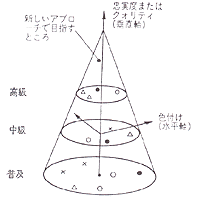 |
| <Fig. No. 1> The way of thinking to playback faithful sound |
In new approach, we are trying to playback music itself faithfully.
We are trying to playback music itself by the playback with faithfulness of playing method, sound image, sound-stage, and balance of music instruments.
Playback music which is stereophonic recorded will not be handicapped to compare with live music. Listen into live music as many times as possible, and found out necessary and indispensable factors which is required to playback live music. We are thinking about the reason and doing experiment/verification, then trying to realize into the system.
In most conventional researches, the beginning point of the system
was signal generator, and the ending point was measurement equipment connected to a microphone. In the new system, the beginning point is music, and the ending point is human heart. It will be a hard work since we are trying to replace live music with audio system which is big different from actual form. We have to research from music aspect to human data processing system and psychological field.
Impulse responses take the place of sine waves
They used to use frequency domain physical data mainly such as sine wave. As every signals are consisted of various sine waves, they consider that if they could plyaback sine waves properly, everything goes well.
Measurement should be simple, however not enough for the evaluation of the transient phenomena like music signals.
In our new approach, impulse wave will be more important than sine
wave as we have to consider and examine mainly in time domain. We consider that all signals are the collections of impulse (Fig. No. 2).
If we could playback impulse properly, it is possible to playback
all signals including transient phenomena. It will be a big mistake, if we consider only from frequency domain aspect.
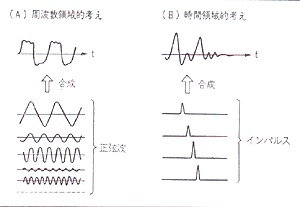 |
| <Fig. No. 2> Collections of sine waves and collections of impulse |
In the listening room, some people use pink noise as a playback signal and receive it by uni-directional microphone, then make it tuning to flat by using graphic equalizer. This is typical extreme example for frequency domain evaluator.
If they do not understand all aspects well enough, something goes wrong. This is an example of ignoring time axis, as the sound is equalized including the remaining sound as room echo and the direct speaker output sound. Also in this kind of idea, the sound direction is neglected because it is equalized including forward sound and backward sound. This example is extreme sample, but this kind of idea always exist in frequency domain consideration. The followings are examples.
Distortion regarding phase and time
Helmholtz described that "Music tone will be decided by its amplitude which consist of sounds, and has nothing to do with phase between constituents", since then people have been considering that phase has nothing to do with sound tone.
Actually, there is a research that there is not so big difference even between extreme signals depicted in Fig. No.3. In case of our additional test we recognized slight difference, however maybe this was telling the non-linear distortion difference on ears or playback equipment caused from the waveform difference, not detecting the phase difference. Judging from these facts, conventional faithful playback method, we left phase distortion unquestioned, however when we consider about music playback seriously , we found out that this will be very important subject.
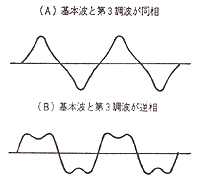 | 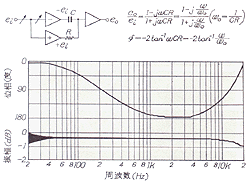 |
| <Fig. No. 3> Reversed phase relationship signals | <Fig. No. 4> Phase shifter used in experiment and its characteristics |
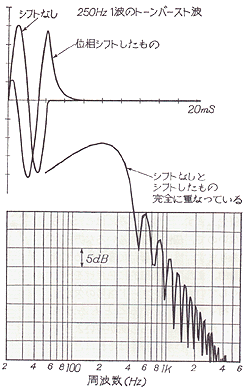 |
| <Fig. No. 5> Waveform and frequency response of burst wave which is phase shifted. |
Sound will be changed even that frequency response is flat
We made a phase shifter as in Fig. No. 4. Amplitude characteristics
(commonly called "frequency response") has been unchanged, and only phase characteristics will continuously changed to 180 degree.
Using this shifter, we listened into various sounds. As a matter of fact, there is no difference using sine waves. Also there is small difference for simple compound wave as in Fig. No. 3, however there will be a big difference between transient sounds. It is easy to understand with not only for impulse but also for a simple one envelope of tone burst wave. In general speaker system, phase distortion exists in speaker system itself, so we will drew the
conclusion that there is no difference from like this experiment.
As in Fig. No. 5, you can see no difference between original signal and phase shifted signal after Fourier transform.
And yet why we hear the sound differently?
There is a key issue in time domain See Fig. No. 6. In upper figure,it is made in total time, and there is no difference like 0.1dB in each frequency elements. However, we can consider that tone is changing as time goes by even in a short period. So it will be clear that reasonable sound difference, a few dB in average and 20 dB at most, will be in frequency elements at each timing made from time window aspects.
It actually sounds as shown in Fig. No. 7, and this fits well with the result. According to this analysis, it looks like high sound in advance and low sound later to human ears from a viewpoint of
time. Fig. No. 8 is a typical system as known frequency response is fairly good, but the same phenomenon as Fig. No. 7 is seen due to phase distortion. Now we can understand the reason why it sound so different in spite of almost same frequency response between two speaker systems. Thus we can call it a momentary tone which is limited in a short period.
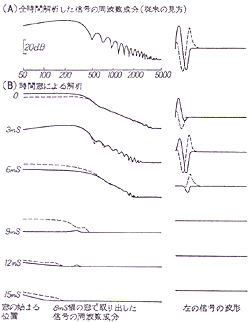 |
| <Fig. No. 6> Time observation of phase shifted signals. Many new aspects will come out from observation using new methods. |
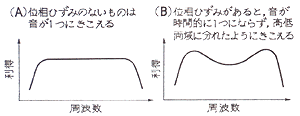 |
| <Fig. No. 7> The way of sound through phase shifter |
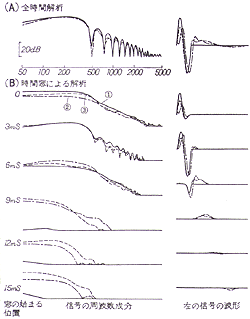 |
| <Fig. No. 8> Time observation through conventional SP system. |
Natural sound and high-class music
As in the previous example, if you listened into the music through
shifter, it sounds unnatural, high and low emphasized sound.
You cannot fix this phenomenon even modified with graphic equalizer. For example, if you listen into female vocal, sounds starting with "S" are emphasized, and not feminine low sounds are stressed also. These are typical characteristics of playbacked sounds, aren't they?
Music sounds very cheap if high-tone sound comes first then lower-sound follows. High-class music accompany with lower sound elements from the starting point, and if it is delayed the sound will become very cheap.
For example, the first class singer uses diaphragm regardless east or west, so it sounds very strong with accompanying fundamental low tone. But, an amateur sings from throat and lungs squeezing air, so it sounds very unstable due to preceding high-tone sound.
The first-class player produces high-class sounds using diaphragm and by tonguing in case of woodwind and brass instruments. In case of string instruments, low sound is mixed from starting point as pla
ying quickly after a bow sticking to the string enough and stocking enough pressure.
In case of poor player or cheap bow, sticking is not enough and as a result we cannot expect this kind of sound. Generally speaking, cheap instruments has a tendency to emphasize high-tone, and not accompanying with low sound, even so sounds not so crispy and clear. If there is phase distortion, it means not only causing time difference in frequency elements and sounds unreal due to an momentary tone difference, but also very hard to get high-class music. Time delay (group delay characteristics) is in proportion to phase slope, so phase slope should be slow and constant.
12dB/oct Reverse phase connection is good
In multi-way speaker system, this phenomenon will occur in dividing filter. The characteristics of dividing method is shown in Fig. No. 9. The sound will not be connected smoothly each other when listening to electrically composite sound through head-phone due to a large phase slope of composite characteristics at 18 dB/oct.
In case of sound composition in air-space using speaker, the connection will be worsen in addition to the phase difference between unit phase difference 90 degree.
In case of 6 dB/oct, composed phase is flat, but actual connection is not always good due to unit phase difference 45degree. Also it is not suitable for high-class audio system due to bad outside band decay characteristics.
From the consideration of outside band decay characteristics, phase difference between units, and composed phase characteristics, 12 dB/oct will be the best.
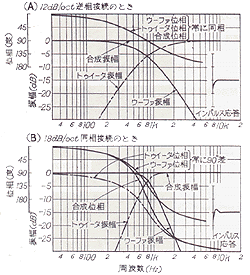 |
| <Fig. No. 9> Characteristics and impulse responses of two filters. |
According to this idea, the method to make it multi-way using speaker-unit for making frequency characteristics flat and wide, is not suitable for playback music faithfully. Since it is impossible to connect correctly in time domain, even smooth connection in frequency response.
Even if it is possible to be connect correctly in calculating with electric signals, but it is impossible to synthesize two waves in short distance. So we came to the conclusion that "2 way" which connects one point with long wavelength will be the best.
Slow roll-off frequency response characteristics and sharp cut-off frequency
response characteristics
@We can say that 12dB/oct is superior to 18dB/oct from the consideration not only amplitude characteristic but also time, phase, also sound connection of composed characteristics. Generally speaking, better characteristics of amplitude characteristics are not directly connected to better characteristics of transient charachteristics. This is not a case only for dividing filter.
It is not suitable filter for audio-frequency band that is considering only amplitude and has flatness to its maximum. Maybe it is suitable for another purpose.
Gentle slope filter has better characteristics such as less phase shift, and better group-delay. In case of the same slope filter characteristics, the filter which has slow roll-off characteristics in shoulder area exibits the better time-phase characteristcs. Fig. No. 10 shows impulse responses which has the flattest amplitude characteristics 24 dB/oct filter and the flattest group delay characteristics 24 dB/oct filters .
Listening into various kind of music, it sounds natural and high-faithful when the filter shape is slow roll-off and group delay flat.
It is natural that the speaker system which shoulder is too overhang to extend the lower range doesn't sound good, since it is a system to deal with transient signals.
(To be continued.)
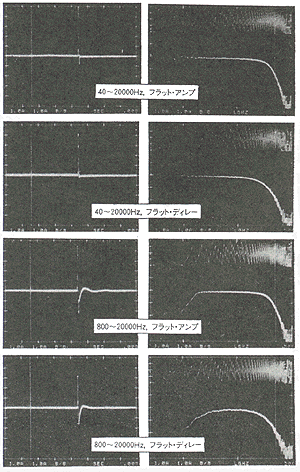 |
| <Fig. No. 10> The relationship between sharp cut-off frequency response and slow roll-off frequency response using impulse signal. |
|